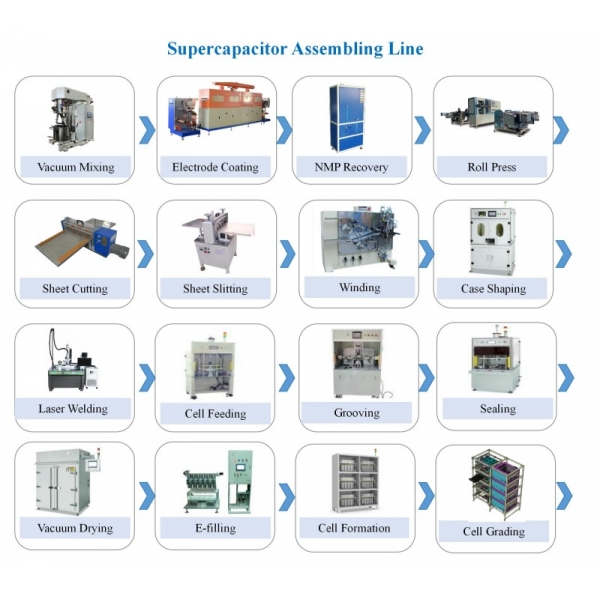Site Blog
contact us
- If you have questions, please contact us, all questions will be answered
- Email : David@tmaxcn.com
- Email : Davidtmaxcn@gmail.com
- Add : No. 39, Xinchang Road, Xinyang, Haicang Dist., Xiamen, Fujian, China (Mainland)
hot products
Supercapacitor Laboratory Equipment: Essential Tools for Research and Development
Supercapacitors, also known as ultracapacitors or electrochemical capacitors, are energy storage devices that bridge the gap between conventional capacitors and batteries. They offer high power density, rapid charge and discharge capabilities, and long cycle life, making them valuable in various applications, including energy storage systems, electric vehicles, and renewable energy sources.
To develop, test, and characterize supercapacitors effectively, researchers and manufacturers rely on specialized laboratory equipment. This article explores the essential equipment used in supercapacitor research and development, their functions, and their importance in the innovation of energy storage technologies.
●Key Laboratory Equipment for Supercapacitor Research
1.Electrochemical Workstation
-Function: An electrochemical workstation is a crucial tool for conducting experiments on supercapacitors. It allows for the measurement of current, voltage, and charge/discharge profiles during electrochemical tests.
-Applications: Used for cyclic voltammetry (CV), galvanostatic charge-discharge (GCD), and electrochemical impedance spectroscopy (EIS) to analyze the performance of supercapacitors under different conditions.
2.Battery Testing System
-Function: This system provides a controlled environment for testing the charge and discharge cycles of supercapacitors. It can simulate various load conditions and operational scenarios.
-Applications: Useful for evaluating energy and power density, cycle life, efficiency, and self-discharge characteristics of supercapacitors.
3.Potentiostat/Galvanostat
-Function: A potentiostat/galvanostat is an essential instrument for controlling the voltage or current in electrochemical experiments. It can precisely measure the response of the supercapacitor during charging and discharging.
-Applications: Employed in research for determining electrochemical performance, analyzing the capacitance, and studying the kinetics of charge transfer processes.
4.Impedance Analyzer
-Function: This equipment measures the impedance of the supercapacitor at different frequencies, providing insight into its electrical properties and internal resistance.
-Applications: Used to characterize the frequency response and identify any resistive or capacitive behaviors in the supercapacitor system.
5.Environmental Chamber
-Function: An environmental chamber allows researchers to test supercapacitors under varying temperature and humidity conditions, simulating real-world operational environments.
-Applications: Important for assessing the stability and performance of supercapacitors under extreme conditions, which is critical for applications in automotive and aerospace industries.
6.Mechanical Press
-Function: A mechanical press is used to compact the electrode materials in supercapacitor fabrication, ensuring uniform density and optimal contact between the components.
-Applications: Essential in the manufacturing process to achieve desired mechanical properties and enhance the performance of the supercapacitor.
7.Synthesis Equipment
-Function: Equipment such as reactors and furnaces are used for synthesizing electrode materials, including carbon-based materials, metal oxides, and conducting polymers.
-Applications: Important for developing advanced materials that improve the performance of supercapacitors in terms of energy density and cycle stability.
8.Microscopy and Imaging Tools
-Function: Tools like scanning electron microscopy (SEM) and transmission electron microscopy (TEM) are used to analyze the morphology and structure of electrode materials.
-Applications: Critical for characterizing the surface area, porosity, and particle size distribution, which directly influence the performance of supercapacitors.
9.Spectroscopy Instruments
-Function: Instruments such as Fourier-transform infrared spectroscopy (FTIR) and X-ray diffraction (XRD) are used to analyze the chemical composition and crystallinity of electrode materials.
-Applications: Important for understanding the material properties and the relationship between the structure and electrochemical performance.
10.Cell Assembly Equipment
-Function: This includes tools and workstations for assembling supercapacitor cells, ensuring proper layering of electrodes, separators, and electrolyte.
-Applications: Critical for maintaining cleanliness and precision during the assembly process, which is essential for the performance and reliability of the final product.
●Importance of Laboratory Equipment in Supercapacitor Development
-Performance Characterization: Accurate measurement and analysis of supercapacitor performance are essential for optimizing their design and material selection.
-Material Innovation: Advanced laboratory equipment enables researchers to explore new materials and fabrication methods, leading to improved energy density and cycle life.
-Quality Control: Rigorous testing and characterization ensure that supercapacitors meet industry standards and performance requirements before commercialization.
-Research Advancement: The ability to conduct detailed electrochemical studies fosters innovation in supercapacitor technology, driving the development of next-generation energy storage solutions.
●Conclusion
Supercapacitor laboratory equipment plays a vital role in the research, development, and manufacturing of these advanced energy storage devices. With a focus on precision, accuracy, and innovation, the right tools enable researchers and manufacturers to push the boundaries of supercapacitor technology, leading to improved performance, efficiency, and application versatility. As the demand for energy storage solutions continues to grow, the importance of high-quality laboratory equipment in advancing supercapacitor technology cannot be overstated.

 ru
ru

 Iris@tmaxcn.com
Iris@tmaxcn.com David@tmaxcn.com
David@tmaxcn.com +86 13174506016
+86 13174506016 18659217588
18659217588